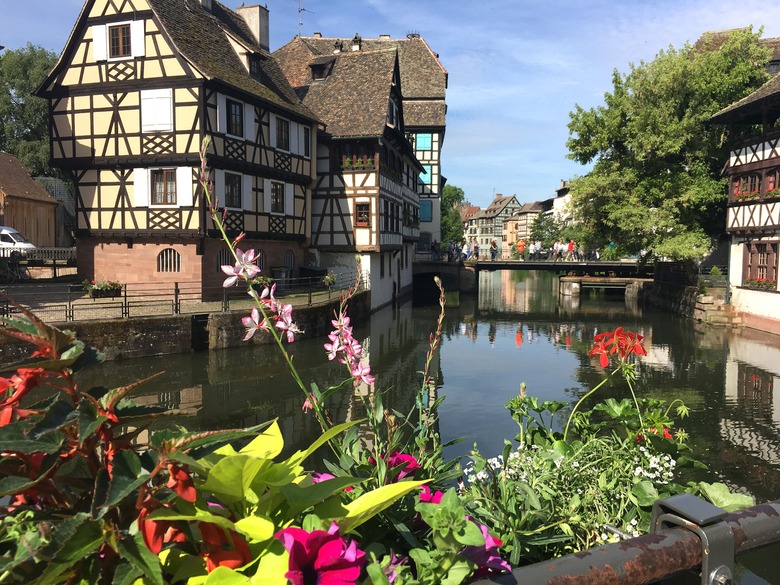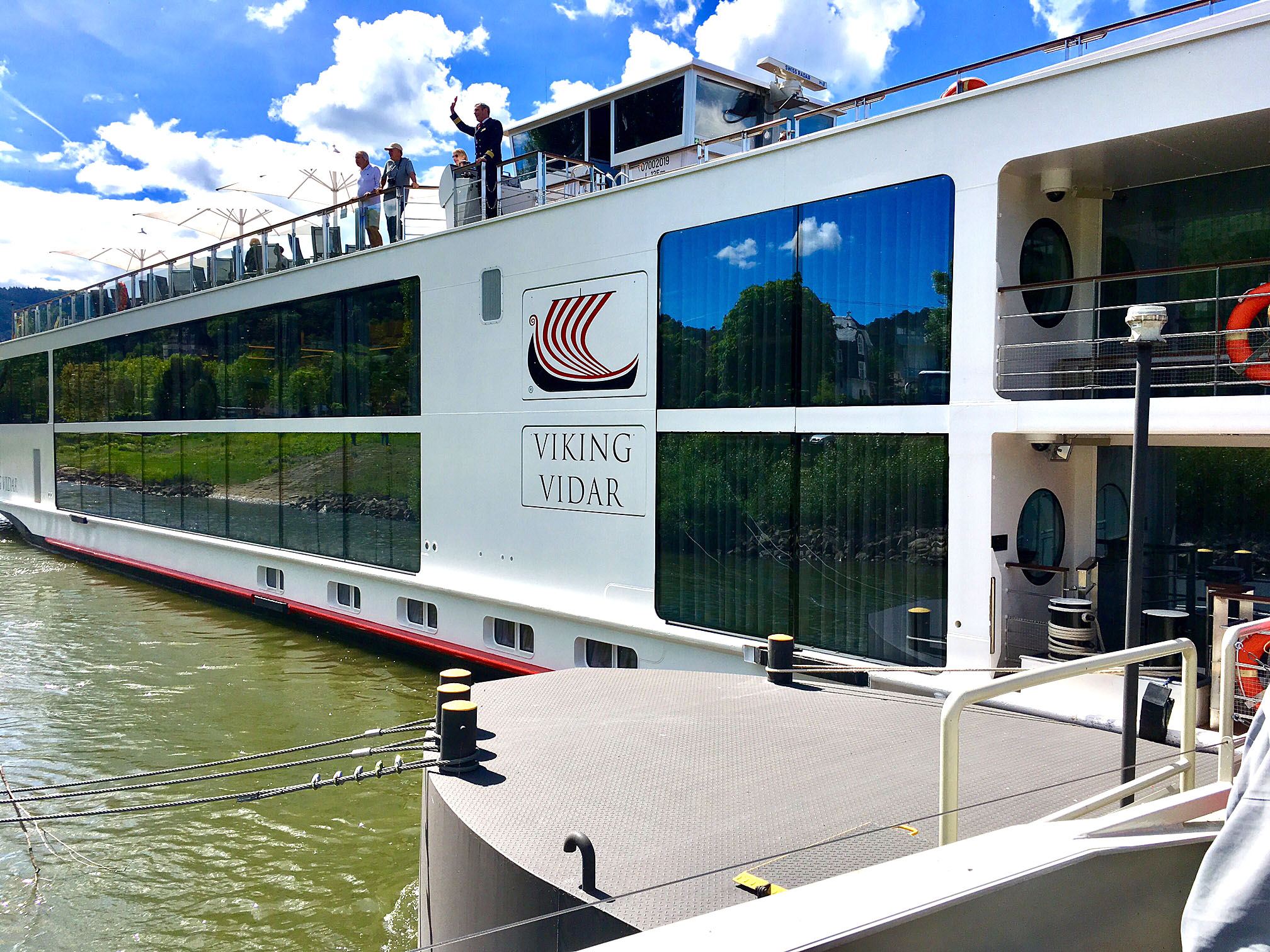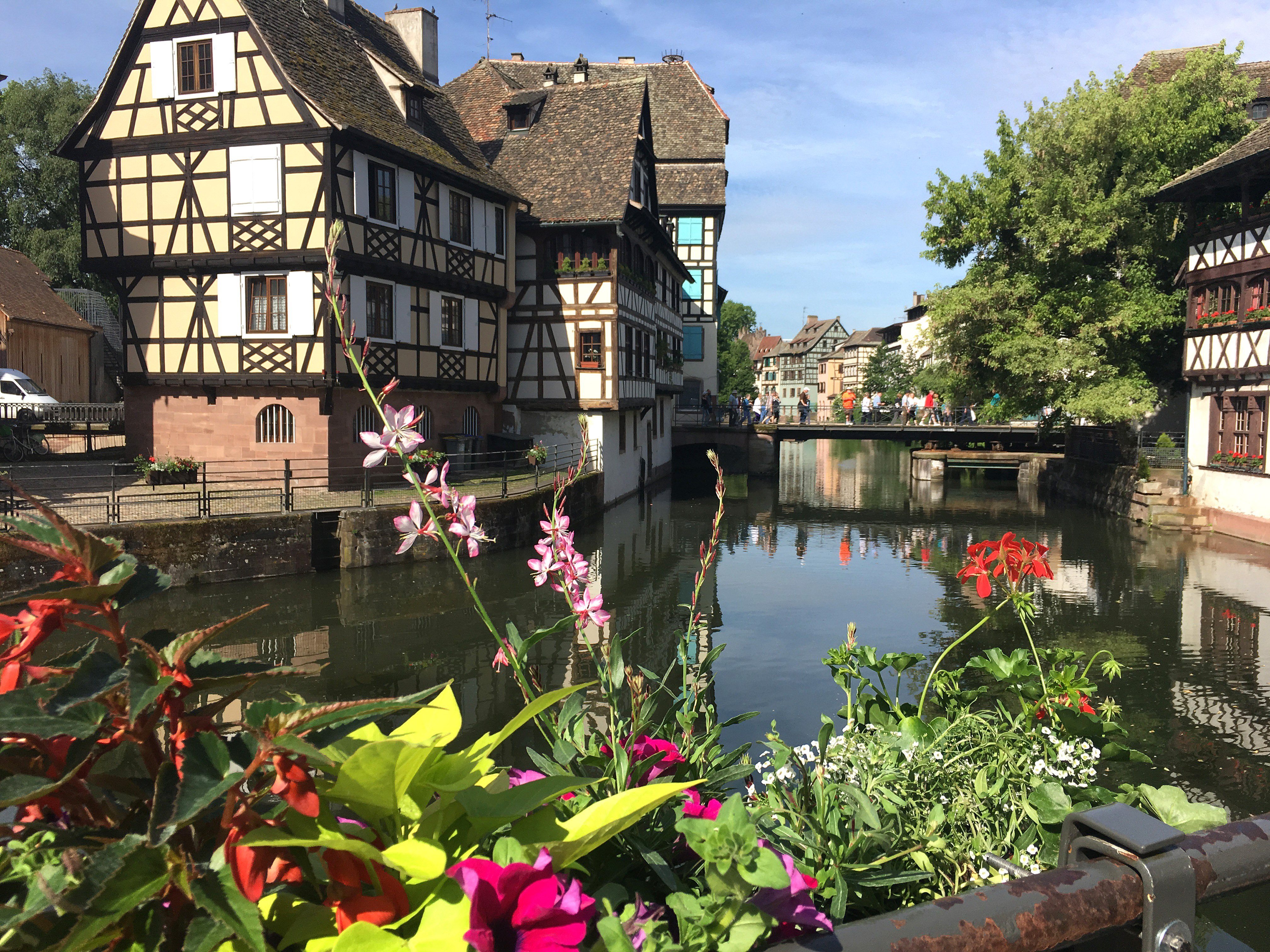A Fabulous Rhine River Getaway With Viking River Cruises
Viking Longships are floating luxury hotels offering all the amenities and service of a five-star resort. From the moment you board a Viking River Cruise, you know you are in for something special. My wife and I were fortunate to be able to sail a second time with Viking aboard the Vidar from the Netherlands to Switzerland. Our seven-day itinerary traversed four countries from Amsterdam to Basel and featured the cities of Kinderdijk, Cologne, Koblenz, Rüdesheim, Heidelberg, Speyer, Strasbourg, and Breisach. Many of the ships in Viking's cruise fleet are named after the gods of Norse mythology, and our ship was named after Vidar, a son of Odin and the god of loyalty.
Day 1: Amsterdam, Netherlands
The Vidar was docked in Amsterdam, and Viking offered walking tours on the first day. When booking our trip, we decided to stay two extra nights to be able to see more of this city. We chose the Doubletree by Hilton, perfectly situated close to the Amsterdam Centraal train and tram stations. From here, you can explore the many areas of Amsterdam, including the Museum Quarter, Anne Frank House, shopping districts, restaurants, and pubs as well as 100 kilometers of interconnected canals.
The iamsterdam city card, available at various locations (including our hotel), provides free access to many museums and transportation as well as discounts on food and other services. A pass, good for 48 hours, costs 67 euros. One of the included activities you must try is the free canal cruise, which glides along the scenic waterways past floating houseboats, colorful residences, and under some of the city's 1,500 stone bridges.
After boarding the Vidar, we were taken to our Veranda Stateroom. Surprisingly spacious at 205 square feet, the room was bright and modern with two beds and floor-to-ceiling sliding glass doors opening to a veranda. Cozy bathrobes were waiting on our beds, as were fresh water and a bottle of sparkling wine.
On-demand movies, music, sports, and news were also available via the Sony 40-inch flat panel TV. Viking has also made technology easy while cruising with standard American 110V sockets as well as 220V 2-pin European outlets. Hair dryers are also included, as is free Wi-Fi. The bathroom comes complete with plush towels, upscale bath amenities, and even a heated floor.
As we made our way to the Aquavit Terrace for a pre-sailing lunch, we were greeted by two staff members who already knew our names. This is one of the great things about Viking: the service! Unlike larger ocean cruise liners, the Vidar has a maximum capacity of 190 passengers, which evokes an intimate river cruising experience. The international crew really goes out of their way to make you feel at home, doing their best to satisfy any request.
The adjacent bar lounge is an open and comfortable space for various events and a good place to enjoy a cocktail, live music, and good conversation. On our first night, the tour director introduced a musical trio as three handsome gentlemen from Amsterdam who played music from the '50s, '60s, and '70s as passengers danced until the wee hours.
Beer, wine, and soft drinks are complimentary during meals. However, guests can choose to add on a Silver Spirits Beverage Package, ($150 per person for a seven-night cruise) which covers all house pouring wines, beers, and liquor like cocktails and mixed drinks.
The Vidar also has a library, internet computers, coffee, and tea stations, and an onboard concierge service for special requests. Breakfast, lunch, and dinner are served in the ship's restaurant although you can also opt to enjoy a bar-style menu in the Aquavit Terrace.
Service in the dining room is a combination of a buffet (breakfast and lunch) and personalized service for these as well as dinner. Guests can choose from a daily selection of entrees or pick something off the always available menu. Our first night, I chose to start with the baby shrimp cocktail followed by the braised beef brisket and meat empanada — all of which were exceptionally delicious. I ended my meal with their "Chocoholic" chocolate-whiskey ice cream, Baumkuchen with chocolate mousse, and a ganache cake.
Day 2: Kinderdijk, Netherlands
After sailing through the night, our ship docked briefly at Rotterdam and then sailed onto Kinderdijk.
This small village in South Holland features 19 windmills dating from the eighteenth century. Designated a UNESCO World Heritage Site in 1997, Kinderdijk has the largest concentration of windmills in the entire country. Sadly, only a fraction of the 150 original windmills have survived over time but this is a fascinating look at how they operated.
These workhorses are a visible tribute to how the Dutch were able to reclaim land from the sea, and today the windmills are surrounded by embankments that keep the waters at bay.
Optional tours also included a visit to a Dutch cheese factory for an inside look at how cheese is made.
Day 3: Cologne, Germany
With a history that dates back 2,000 years to the Romans, Cologne is one of Germany's four major cities along the banks of the Rhine River. After being bombed heavily by the allies in World War II, the city has been rebuilt with a mixture of various types of architecture.
Don't miss a UNESCO World Heritage Site that escaped destruction during WWII, the 1880 Kölner Dom, a Gothic cathedral. With its towering twin spires and elegant stained glass windows, it is considered the largest Gothic cathedral in Northern Europe.
Popular spots in the city include the Hohe Strasse or pedestrian zone with shopping, restaurants, and boutiques as well as the chocolate museum, Wallraf-Richartz Museum, and House of 4711. The latter is one of the most famous perfumeries in Europe and has been in operation since 1792.
Day 4: Koblenz and Rüdesheim, Germany
Our ship gently slid into dock in Koblenz right at the famous Deutsches Eck, or "German Corner." Situated at the confluence of the Rhine and Moselle Rivers, this city has a history dating back 2,000 years (it also began as a Roman settlement). A strip of land marks the confluence of both rivers at the popular Deutsches Eck, where visitors can gaze upon the colossal bronze statue of Kaiser Wilhelm I on horseback, triumphantly towering 120 feet above the city and affording grand views of the area from its pedestal.
Not to be missed is the cable car excursion to the Ehrenbreitstein Fortress that overlooks the town. The cars float silently over the Rhine and are among the largest in Germany in terms of capacity, able to transport 7,600 people per day.
The fortress, the second largest in the world, was constructed between 1817 and 1828 by the Prussians as part of the area's fortification system. Upon reaching the summit, you can stroll through the passageways and enjoy cultural exhibitions. A local beer called Festungs Bräu is brewed just for the fortress, and you can enjoy a stein while taking in a bird's-eye view of Koblenz.
From a large city to a small town, Rüdesheim is as cozy, charming, and picturesque as any town you are likely to find in Germany. Located in the Upper Middle Rhine Valley, the area is known for its vineyards, but there is much more to see and do here. You can explore nature by walking along many excellent and scenic hiking trails that overlook the Rhine, visit ancient castles, and sample some of the finest riesling and pinot noir wines in the region.
The town's meandering lanes look like something out of a fairy tale with half-timbered houses, hidden courtyards, and small hotels and eateries. Here, you can make arrangements (on a separate trip, of course) to actually sleep in a large wine barrel (cozy but more spacious than you might think)!
One of the optional excursions is a night of food and fun at Rüdesheimer Schloss for dinner. Owner Susanne Breuer makes every guest to her hotel/restaurant feel like family. She insists on providing the best in fresh, local ingredients for her meals. Make sure you also try the Rüdesheim coffee, a local specialty that you won't want to miss — even if you aren't a coffee drinker!
Day 5: Heidelberg and Speyer
Located due south of Frankfurt, Heidelberg was our next stop, although a bus took us from Mannheim to this city. "Old" and "modern" might both be good ways to describe Heidelberg, and both concepts are integrated into the town's infrastructure. Pedestrian paths with cobblestone streets line the main shopping areas with church steeples and a towering city gate still majestically guarding the entrance to the town.
A visit to the twelfth-century Heidelberg Castle, perched on a hill above the city, is included in the Viking tour and offers a great vantage point from which to view the entire town. The castle was destroyed in earlier days, but the ruins are well preserved and colorfully lit for the holidays. A tour bus and local guide escorted us to the most interesting parts of the fortress, including the world's largest wine cask, which apparently held enough wine to keep 5,000 guests and castle dwellers in, shall we say, good spirits.
Other sights that should be on your must-see list include the Old Bridge spanning the Neckar River and built by Prince-Elector Karl Theodor in the late 1700s as well as the Student Prison. Yes, you heard right. Any minor infraction would land students of Ruprecht-Karls University in what amounts to a modified detention for a few days — at their convenience, of course. Today, you can tour the jail and view the artwork — created by the "guests" — that adorns the walls and ceilings.
The Vidar moved without us down the Rhine to Speyer, where we met up with her via our bus. A roughly 30-minute walk from the river will take you to this town and its most impressive landmark, the Imperial Cathedral (a UNESCO World Heritage Site), the final resting place of eight emperors from the Holy Roman Empire.
There are other noteworthy areas of town to explore, including the Jewish quarter, German baths that date from 1126, and a modern Automobile and Technology Museum. This museum houses an entire U-boat and a full-sized Lufthansa 747 jumbo jet.
Day 6: Strasbourg, France
Strasbourg is truly an international city — its Grande Île, which constitutes the entire city center, was selected as a UNESCO World Heritage of Humanity Site in 1988. With winding cobblestone streets, flower-laden bridges, half-timbered houses, and plenty of shops and restaurants, Strasbourg is an amazing place to visit.
You might be so enchanted with this town that you could easily miss one of its most feathered attractions: white storks. Long considered a symbol of fertility and good luck, the storks can nest atop trees on the outskirts of town as well as in the Parc de l'Orangerie.
The pièce de résistance, however, would have to be the Cathedral Notre Dame de Strasbourg. Construction of this Gothic work of art started in 1015 and the spire was finally placed in 1439. Today, this magnificent cathedral is undergoing renovation, but you can still tour the inside and see the massive astronomical clock dating from 1843.
Day 7: Breisach, Germany
This small German town is the docking point for a foray into the Black Forest, which lies to the east across the Rhine. The soil here is rich and fertile, producing wines that are shipped all over the world.
Viking offers a couple of excursions including an optional World War II tour to revisit historic battles fought here. We opted for the combination tour of the Black Forest and the medieval town of Colmar, which took up much of the day but was fascinating and well worth the time.
Sometimes called Little Venice, Colmar is picture-perfect with lovely pastel-colored half-timbered houses, Gothic churches, and even canals intersecting the cobbled lanes.
One of the unexpected sights you can find here is a 12-meter-high replica of the Statue of Liberty. This one can be found in one of the roundabouts and was created as a tribute to the life Colmar native Frederic Auguste Bartholdi, the famous sculptor who created the Statue of Liberty in New York City.
The Black Forest, or "Schwarzwald" in German, is something of a misnomer, since the entire area is a rich green tapestry of verdant farmland, rolling hills, and evergreen trees, and some of your best photo ops will be here. We visited a cuckoo clock factory, sampled authentic Black Forest ham, and learned how they make the famous Black Forest cake. The key ingredient, in addition to sponge cake and real whipped cream, is kirschwasser, a cherry brandy made from Morello cherries. Watch out though as the chriesiwässerli (as it is known in the local Markgräflerisch dialect) is about 45 percent alcohol!
Day 8: Basel, Switzerland
This is the final stop along Viking's Rhine Getaway and the disembarkation point. You can choose to extend your trip here or go to another wonderful city — Lucerne, Switzerland. You won't want to miss the Swiss Museum of Transportation (the most popular museum in the country) and the Golden Round Trip. The latter is a three-part excursion that includes a ferry ride across Lake Lucerne and a trip up an inclined railway to the top of Mount Pilatus with a cable car descent along the spine of the mountains.
One of the things that is very impressive about Viking is the organization. From the tour buses to local guides to the program director (ours was Nicole, and she was fantastic!), everything has been perfected down to a science. You will know when to get ready and leave, what to bring, and how you will be fed throughout the day.
The service is also impeccable. Every crew member is trained to put the needs of the guests first, and it shows. I badly sprained my ankle at the beginning of my trip and couldn't find a suitable bandage to wrap it. Once the staff saw me limping, they scoured the local town and delivered just what I needed to my room — with a smile, of course!
FTC Disclosure: This was a sponsored trip; however, all opinions herein are the author's.


